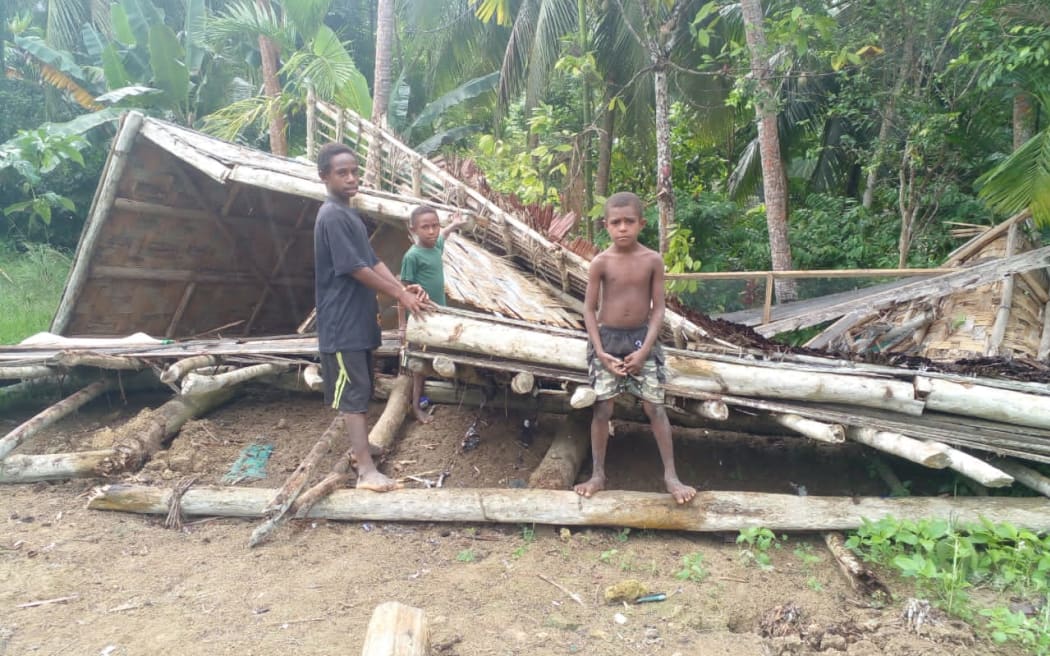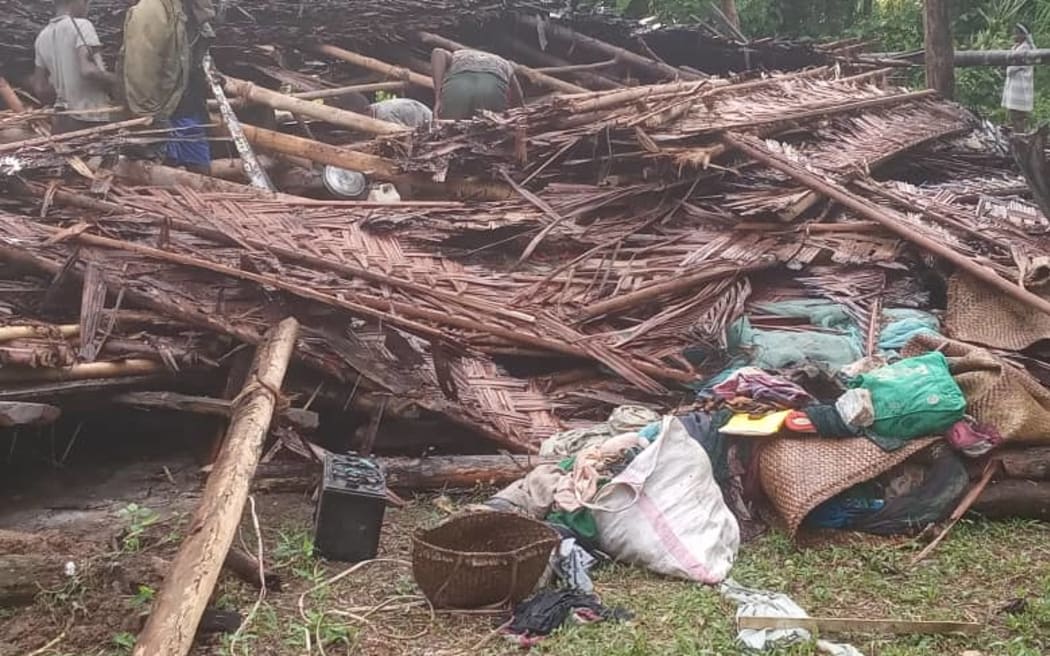13 April 2023
Caleb Fotheringham, RNZ Pacific Journalist

Over 800 houses were destroyed after a magnitude-7.0 earthquake struck Papua New Guinea's East Sepik province on April 4.
Photo: NBC East Sepik / Edward Hagoria
The governor of the Papua New Guinea province worst-hit by last week's earthquake feared the death toll was going to be much higher.
Eight people are confirmed dead after the magnitude 7.0 earthquake struck East Sepik at around 4am on Monday last week.
The epicentre hit Chambri Lake, about 100km south-west of Wewak at a depth of 60km.
An assessment report from the East Sepik Provincial Disaster and Emergency office said over 800 houses were destroyed.
In the district of Angoram alone 542 houses were lost.
East Sepik's Governor Allan Bird said he initially thought the loss of lives and damage was going to be much greater.
"We felt we were lucky," he said.
"It was eight lives lost which is obviously sad, you don't want to lose anyone, but I guess from a response standpoint we were fairly relieved that it wasn't worse."
Bird said people built their homes in swampy places in the Karawari area of Angoram.
"They actually build their homes on peat and it's not a very stable material," Bird said.
"I think almost 300 homes collapsed in that particular area."
Bird said the government was providing help with basic tools, nails and tarpaulin to support the rebuild. Also being provided was clothing, mosquito nets, water containers and fishing nets.
He estimated the overall cost to rebuild would be about $2 million Kina, or around $US500,000.
"We think we will be spending about 1000 Kina ($US280) to re-equip a family so they can get back to normal.
"Then another 1000 Kina, for logistics to get the help out there, because these places are really far flung and isolated. You need a helicopter to reach them or go by road and then by speedboat."
Too scared to search for food and water
The report from the East Sepik Provincial Disaster and Emergency office said for most people they had never felt an earthquake of such magnitude and would take time to "absorb the realities of such extreme natural hazards".
Luke Baskam, from Wewak, where there was one death, said people in the area normally went out to catch fish and collect sago but were not doing it now out of fear of aftershocks.
"Right now they are scared of the earthquake and they're staying at home," Baskam said.
"They can't move to find food or water. They're scared an earthquake will come and kill them, that's why they're scared of moving."
Baskam said there had been not much support from the government despite hearing on the radio that help was coming.
"They're not doing it fast, they're very slow at moving things."
The governor of the Papua New Guinea province worst-hit by last week's earthquake feared the death toll was going to be much higher.
Eight people are confirmed dead after the magnitude 7.0 earthquake struck East Sepik at around 4am on Monday last week.
The epicentre hit Chambri Lake, about 100km south-west of Wewak at a depth of 60km.
An assessment report from the East Sepik Provincial Disaster and Emergency office said over 800 houses were destroyed.
In the district of Angoram alone 542 houses were lost.
East Sepik's Governor Allan Bird said he initially thought the loss of lives and damage was going to be much greater.
"We felt we were lucky," he said.
"It was eight lives lost which is obviously sad, you don't want to lose anyone, but I guess from a response standpoint we were fairly relieved that it wasn't worse."
Bird said people built their homes in swampy places in the Karawari area of Angoram.
"They actually build their homes on peat and it's not a very stable material," Bird said.
"I think almost 300 homes collapsed in that particular area."
Bird said the government was providing help with basic tools, nails and tarpaulin to support the rebuild. Also being provided was clothing, mosquito nets, water containers and fishing nets.
He estimated the overall cost to rebuild would be about $2 million Kina, or around $US500,000.
"We think we will be spending about 1000 Kina ($US280) to re-equip a family so they can get back to normal.
"Then another 1000 Kina, for logistics to get the help out there, because these places are really far flung and isolated. You need a helicopter to reach them or go by road and then by speedboat."
Too scared to search for food and water
The report from the East Sepik Provincial Disaster and Emergency office said for most people they had never felt an earthquake of such magnitude and would take time to "absorb the realities of such extreme natural hazards".
Luke Baskam, from Wewak, where there was one death, said people in the area normally went out to catch fish and collect sago but were not doing it now out of fear of aftershocks.
"Right now they are scared of the earthquake and they're staying at home," Baskam said.
"They can't move to find food or water. They're scared an earthquake will come and kill them, that's why they're scared of moving."
Baskam said there had been not much support from the government despite hearing on the radio that help was coming.
"They're not doing it fast, they're very slow at moving things."

Photo: NBC East Sepik / Edward Hagoria
No comments:
Post a Comment